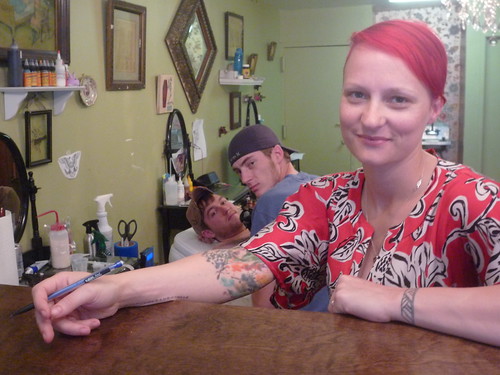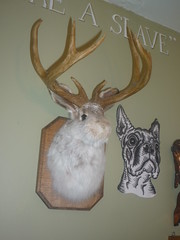White Rabbit Tattoo Studio may be the East Village’s only vegan tattoo parlor, but some animals were harmed in its making. The heads of an elk and a “jackalope” — a real rabbit with real antlers glued to its head — are mounted on the wall. Taxidermy aside, this particular tattoo parlor is attempting to carve out a rare niche in a neighborhood where there’s seemingly one for every block.
“The inks we use contain no animal byproducts, and instead contain vegetable glycerin,” said Jessica Ashby, the owner and one of the artists at White Rabbit. “We also provide vegan soaps for treating the tattoos. In this way, we are able to remain 100 percent vegan.”
The idea of a completely vegan tattoo parlor came as a surprise to one die-hard tattoo artist.
“I have never heard of vegan tattoo parlors,” said Bill Johnson, the vice president of the National Tattoo Association, a 35-year-old group that organizes a convention every year. “I knew someone who was a vegan, but he didn’t seem to have a problem getting tattoos at regular tattoo shops.”
Ms. Ashby owned and operated another vegan White Rabbit Tattoo Studio in London, but relocated the shop to the East Village this past November after her husband, a banker, was transferred to a new job in New York.
She said that about half of her customers are true vegans, while the others come for the White Rabbit style, which she described as “more abstract.”
“I do get more hipster-type clients here than in London,” Ms. Ashby said.
Some customers at White Rabbit said they relished the chance to get inked up guilt-free.
“I tend to be very vegan influenced,” said Bradley Curry, a local non-vegan who was getting a tattoo of a bar code on his shoulder. “I understand the philosophy behind it, and I’m trying to educate myself, which hopefully will compel me to be more mindful of harmful situations for animals.”
There may be other incentives to getting a vegetable-based tattoo besides a clean conscience— some think the ink makes for a higher quality design.
“My vegan friends told me that products they put into the ink here are the best— they don’t fade,” Mr. Curry said.
Mr. Johnson was skeptical. “You can’t really say what the quality of a tattoo is until 10 or even 20 years after you get one,” he said. “It might look great right after you get it, but the true test is the test of time.”
Even as Mr. Curry had his animal-free tattoo applied, the jackalope and elk heads looked on from above. But Ms. Ashby had a justification for this uniquely un-vegan artwork.
“The animal heads that are mounted on the walls have in some way been recycled,” she said. “It’s part of the Ouija board creepiness we wanted to go for.”






